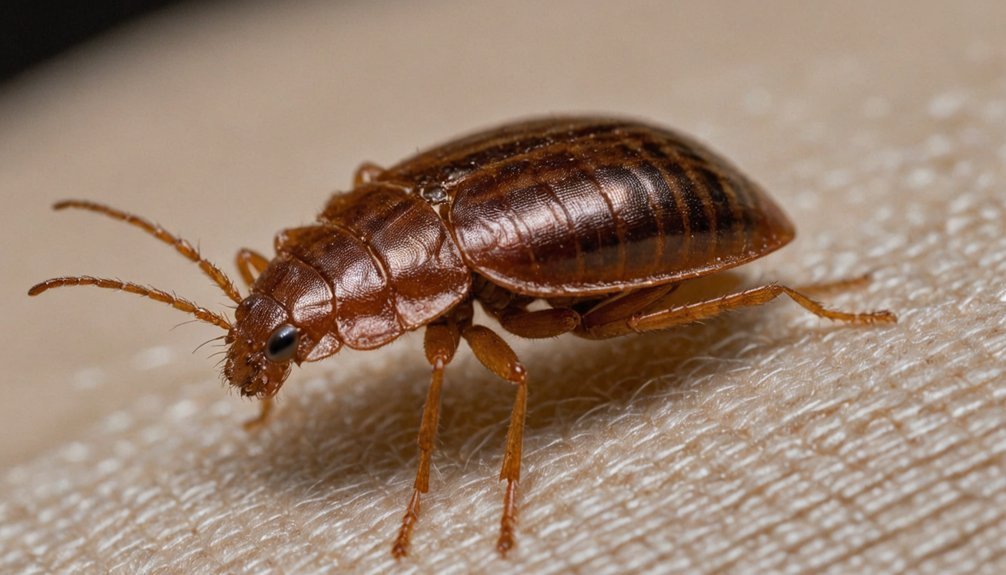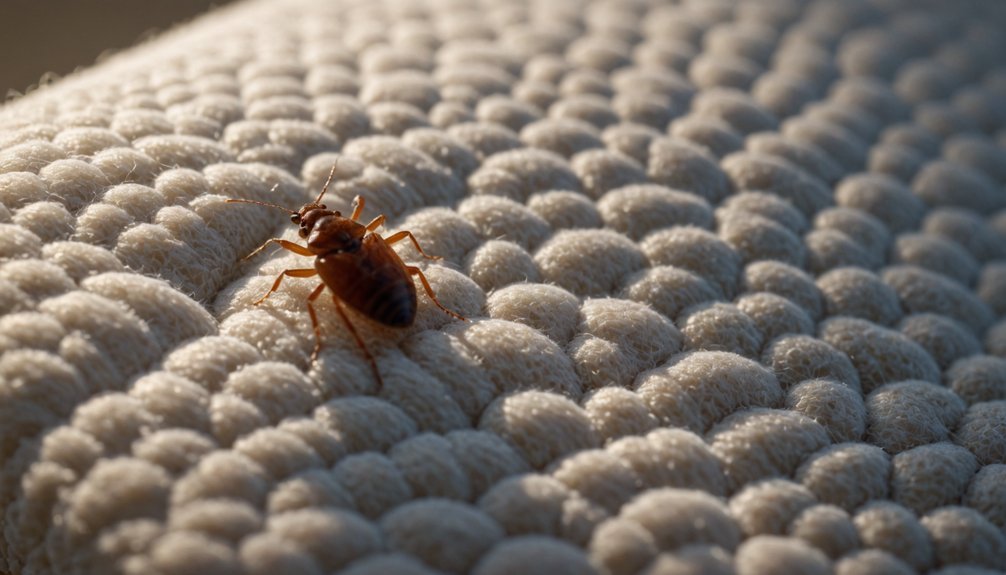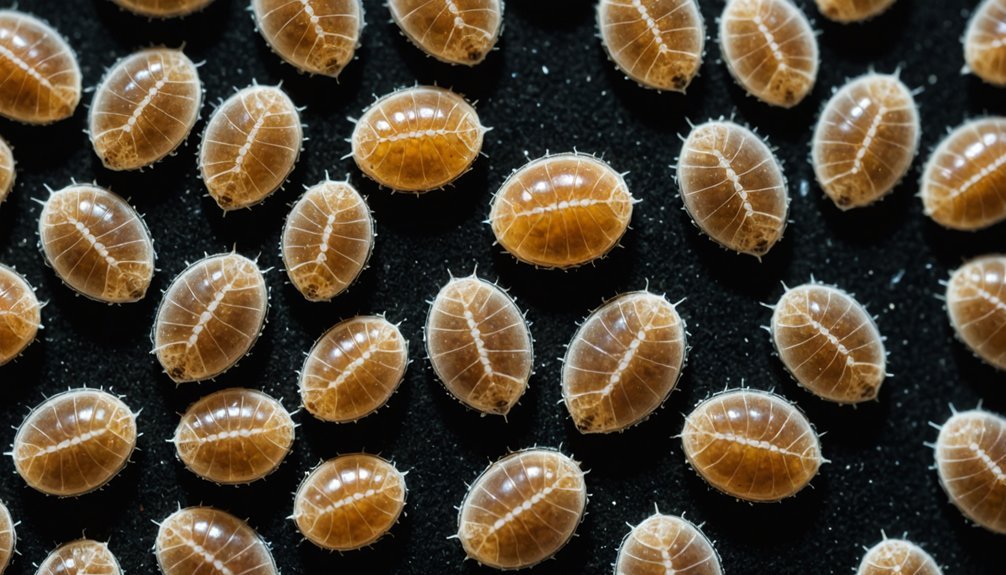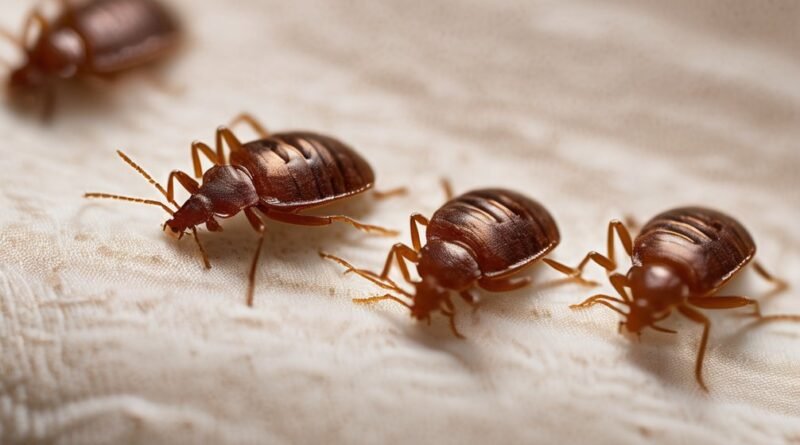Can You See Bed Bugs With the Naked Eye?
If you’re concerned about bed bugs in your home, you’ll want to know if these unwelcome visitors are visible to your eyes. While adult bed bugs are indeed detectable without magnification, spotting them isn’t always straightforward. Their sneaky behavior, varied life stages, and clever hiding spots can make identification tricky. Understanding what to look for and where to search will greatly improve your chances of catching these elusive pests before they become a bigger problem.
Key Takeaways
- Adult bed bugs are visible to the naked eye, measuring 4-7mm in length and appearing similar to apple seeds.
- Nymphs (baby bed bugs) can be harder to spot without magnification, as they’re only 1-5mm and nearly translucent.
- After feeding, bed bugs become more noticeable as their bodies swell and turn reddish-brown.
- Bed bug eggs are difficult to see without magnification, being pearl-white and only the size of a pinhead.
- Visual signs like rusty bloodstains and dark fecal spots are easier to spot than the bugs themselves.
Adult Bed Bug Visibility: Size and Appearance

Adult bed bugs are clearly visible to the naked eye, measuring about 4-7 mm in length – roughly the size of an apple seed.
You’ll notice their flat, oval-shaped bodies are light to reddish-brown in color, with a smooth, shiny exoskeleton that helps them hide in furniture crevices.
When these pests haven’t fed, they’re as thin as a credit card, but their appearance changes dramatically after a blood meal. Their bodies become elongated and swollen, taking on a football shape with a darker red abdomen. Due to their nocturnal feeding habits, they typically bite and consume blood while humans are sleeping.
You can spot them more easily when they’re moving, especially at night during their active hours. Despite being visible, they’re masters at concealment, preferring to stay hidden in cracks and crevices during daylight hours.
Spotting Bed Bug Nymphs: Challenges and Tips

While adult bed bugs are relatively easy to spot, their nymphs present a far greater challenge to the untrained eye. These tiny offspring, ranging from 1mm to 5mm, are particularly difficult to see during their early stages when they’re nearly translucent and pinhead-sized.
You’ll have the best chance of spotting nymphs right after they’ve fed, as their bodies become bright red and swollen with blood. These nymphs must feed to moult and develop through five distinct growth stages.
To detect these elusive pests, you’ll need a bright flashlight and possibly a magnifying glass. Focus your inspection on mattress seams, furniture crevices, and baseboards, where nymphs typically hide.
Don’t confuse them with other small insects like booklice or carpet beetle larvae. Watch for their slow, ant-like movement patterns and look for recently fed nymphs, which are more visible due to their reddish coloring.
Understanding Bed Bug Egg Detection

Because bed bug eggs are incredibly tiny, about the size of a pinhead, you’ll need keen attention to detail to spot them during an inspection. These pearl-white, translucent eggs often cluster in groups of 10-50, making them easier to identify despite their small size. Adult bed bugs are much easier to spot since they are reddish-brown in color and resemble apple seeds.
Location | Characteristics
———|—————
Mattress seams | Sticky shells adhering to surfaces
Furniture joints | Hidden in dark crevices
Baseboards | Near potential feeding sites
You’ll find these eggs in concealed spots close to sleeping areas, though infestations can spread to adjacent rooms over time. While they’re visible to the naked eye, you might mistake them for dust particles without proper lighting and magnification. Look for developing eyespots in eggs older than five days, and use a flashlight and magnifying glass to improve your detection accuracy.
Key Physical Signs of Bed Bug Presence
You’ll often spot bed bug evidence through visible blood stains on sheets and mattresses, which appear as rusty or reddish-brown marks from crushed bugs.
These telltale stains typically cluster in areas where bed bugs feed or move, providing clear proof of their presence.
Beyond blood marks, you’ll want to look for additional physical signs like dark fecal spots, shed skins, and live bugs themselves to confirm an infestation. The live bugs are easy to identify, as they appear rusty-red in color and reach about the size of an apple seed.
Visible Blood Stains
One of the most telltale signs of bed bugs is the presence of visible blood stains on your bedding, mattress, and nearby furniture.
You’ll typically notice small, reddish-brown spots that cluster around areas where bed bugs feed or get crushed, particularly near the head and foot of your bed.
These stains often appear in mattress seams, pillowcases, and bed linens, usually about the size of a pen tip.
Fresh stains look glossy and red, while older ones dry to a darker, rust-like color.
If you find multiple blood stains paired with dark fecal spots and shed skins, you’re likely dealing with an active infestation.
The more stains you discover, especially in clusters, the more severe your bed bug problem may be.
Try cleaning fresh blood stains immediately with cold water and bicarbonate for the best chance of removal.
Signs Beyond Live Bugs
While spotting live bed bugs provides definitive proof of infestation, several other physical signs can reveal their presence in your home.
Look for dark, rusty spots about the size of a pen tip on your mattress, sheets, and headboard – these are fecal stains from digested blood.
You’ll also find pale yellow, translucent exoskeletons where bed bugs have molted, typically near mattress seams and furniture cracks.
Check carefully for tiny white eggs and eggshells, about 1mm long, clustered in seams and crevices.
In heavy infestations, you might notice a distinctive musty or sweet almond-like odor.
These signs often appear together and warrant immediate attention, even if you haven’t seen the bugs themselves.
Common Hiding Places and Where to Look
To effectively spot bed bugs during an inspection, it’s crucial to understand their preferred hiding spots throughout your home. Check your mattress thoroughly, focusing on seams, tags, and folds where these pests commonly cluster.
Don’t forget to examine your bed frame, headboard, and box spring.
Look beyond your bed too. Inspect upholstered furniture, especially couch cushions and seams.
You’ll need to check wall cracks, loose baseboards, and gaps behind electrical outlets. These insects can squeeze into spaces as thin as a credit card.
Don’t overlook your personal belongings. Bed bugs often hide in luggage, clothing, and dresser drawers.
They prefer dark, undisturbed spaces and will spread from bedrooms to other rooms as their population grows.
Best Conditions for Visual Detection
Successfully spotting bed bugs requires ideal lighting and environmental conditions during your inspection.
You’ll have the best visibility using bright, natural sunlight or a strong flashlight to illuminate dark crevices. For optimal detection, remove clutter and pull furniture away from walls to improve access.
While you can inspect any time, bed bugs are most active at night, making evening inspections particularly effective. Early morning checks help you spot fresh signs like blood spots or fecal marks.
Keep in mind that bed bugs are easier to see against light-colored surfaces, and you’ll find them most often in fabric folds and mattress seams.
Using magnification tools can help you identify smaller specimens like eggs and nymphs, which are harder to spot with the naked eye.
Tools and Techniques for Better Identification
You’ll need basic tools like a bright flashlight, magnifying glass, and credit card-sized probe to conduct an effective bed bug inspection.
A quality LED flashlight helps spot tiny bed bugs in dark cracks, while the magnifying glass enables you to examine suspicious marks and insects up close.
Using a thin probe or card lets you check seams and crevices where bed bugs commonly hide, making your visual inspection more thorough and accurate.
Essential Inspection Equipment Needed
Identifying bed bugs effectively requires specific tools and equipment designed for thorough inspection.
You’ll need both basic and specialized tools to spot these elusive pests in their hiding spots.
Professional detection kits combine high-intensity blue lights with orange filter goggles to reveal proteins from bed bugs, while basic household tools like LED flashlights and magnifying glasses help examine suspicious areas.
- Use a professional CSI BedBug Detection Kit that includes specialized goggles, blue LED flashlight, forceps, and magnifiers for enhanced visualization.
- Keep basic tools handy, including bright LED flashlights, 4x magnifying glasses, and screwdrivers for dismantling furniture.
- Install bed bug interceptors under furniture legs to monitor and trap bugs moving to and from sleeping areas.
- Consider advanced tools like infrared thermometers or CO2 traps for more precise detection in challenging situations.
Visual Detection Best Practices
To effectively spot bed bugs during an inspection, you’ll need to combine proper lighting, magnification tools, and systematic search techniques. Use a high-intensity flashlight to illuminate dark crevices and seams where these pests hide, particularly around mattresses, bed frames, and furniture joints.
Don’t forget to employ magnifying glasses for detecting smaller signs like eggs and fecal matter.
Look for telltale signs including rusty bloodstains, dark fecal spots that smear when wiped with a damp cloth, and shed skins that resemble clear bed bug shells.
You can confirm an active infestation by finding live bugs, which are oval-shaped, brownish insects about 5-7mm long.
Pay attention to any sweet, musty odors similar to overripe berries, as this can indicate a severe infestation.
Conclusion
You’ll be able to spot adult bed bugs with your naked eye, as they’re about the size of an apple seed. While nymphs and eggs are harder to see, you can detect them by looking closely in well-lit areas, particularly around mattress seams and headboards. For the best results, use a flashlight and magnifying glass during your inspection, and watch for signs like dark spots and shed skins.

